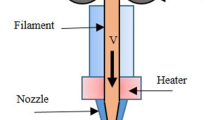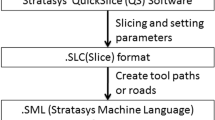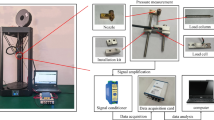Abstract
Die swelling is one of the paramount factors that impresses dimensional accuracy and quality of functional parts in Fused Deposition Modeling (FDM), one of the most famous Additive Manufacturing (AM) processes. Die swelling is considered a critical phenomenon in polymer extrusion process affected by melt flow rate, extruder temperature and its geometry. In this research, the ABS melt polymer behavior in the extrusion process of FDM and the die swell of extruded polymer have been investigated by empirical experiments and simulated by the Finite Element Method (FEM) using rheological properties of ABS. The internal geometry of the nozzle is investigated via analytical simulation and finite element analysis to obtain pressure and velocity distributions of the material inside the extruder as well as the die swell of extruded filament. Additionally, experiments were carried out to validate the analytical and numerical simulations. The results showed that higher melt temperature and lower material flow rate result in less pressure drop inside the nozzle and less swelling of the extruded filament.















Similar content being viewed by others
References
Horta J, Simões F, Mateus A (2017) Large scale additive manufacturing of eco-composites. International Journal of Material Forming:1–6
Ryder MA, Lados DA, Iannacchione GS, Peterson AM (2018) Fabrication and properties of novel polymer-metal composites using fused deposition modeling. Compos Sci Technol 158:43–50
Bikas H, Stavropoulos P, Chryssolouris G (2016) Additive manufacturing methods and modelling approaches: a critical review. Int J Adv Manuf Technol 83(1–4):389–405
Garg A, Bhattacharya A, Batish A (2016) On surface finish and dimensional accuracy of FDM parts after cold vapor treatment. Mater Manuf Process 31(4):522–529
Grimmelsmann N, Kreuziger M, Korger M, Meissner H, Ehrmann A (2018) Adhesion of 3D printed material on textile substrates. Rapid Prototyp J 24(1):166–170
Carneiro O, Silva A, Gomes R (2015) Fused deposition modeling with polypropylene. Mater Des 83:768–776
Aliheidari N, Tripuraneni R, Ameli A, Nadimpalli S (2017) Fracture resistance measurement of fused deposition modeling 3D printed polymers. Polym Test 60:94–101
Uddin M, Sidek M, Faizal M, Ghomashchi R, Pramanik A (2017) Evaluating mechanical properties and failure mechanisms of fused deposition modeling acrylonitrile butadiene styrene parts. J Manuf Sci Eng 139(8):081018
Novakova-Marcincinova L (2012) Application of fused deposition modeling technology in 3D printing rapid prototyping area. Manuf Ind Eng 11(4):35–37
Gaal G, Mendes M, de Almeida TP, Piazzetta MH, Gobbi ÂL, Riul A Jr, Rodrigues V (2017) Simplified fabrication of integrated microfluidic devices using fused deposition modeling 3D printing. Sensors Actuators B Chem 242:35–40
Elgeti SN (2011) Free-surface flows in shape optimization of extrusion dies. RWTH Aachen University
Domingo-Espin M, Puigoriol-Forcada JM, Garcia-Granada A-A, Lluma J, Borros S, Reyes G (2015) Mechanical property characterization and simulation of fused deposition modeling polycarbonate parts. Mater Des 83:670–677
Heller BP, Smith DE, Jack DA (2016) Effects of extrudate swell and nozzle geometry on fiber orientation in fused filament fabrication nozzle flow. Addit Manuf 12:252–264
Mu Y, Hang L, Chen A, Zhao G, Xu D (2017) Influence of die geometric structure on flow balance in complex hollow plastic profile extrusion. Int J Adv Manuf Technol 91(1–4):1275–1287
Bellini A (2002) Fused deposition of ceramics: a comprehensive experimental, analytical and computational study of material behavior, fabrication process and equipment design. Drexel University
Ramanath H, Chua C, Leong K, Shah K (2008) Melt flow behaviour of poly-ε-caprolactone in fused deposition modelling. J Mater Sci Mater Med 19(7):2541–2550
Mostafa N, Syed HM, Igor S, Andrew G (2009) A study of melt flow analysis of an ABS-Iron composite in fused deposition modelling process. Tsinghua Science & Technology 14:29–37
Saadat A, Nazockdast H, Sepehr F, Mehranpour M (2010) Linear and nonlinear melt rheology and extrudate swell of acrylonitrile-butadiene-styrene and organoclay-filled acrylonitrile-butadiene-styrene nanocomposite. Polym Eng Sci 50(12):2340–2349
Agrawal A (2014) Computational and mathematical analysis of dynamics of fused deposition modelling based rapid prototyping technique for scaffold fabrication
Tadmor Z, Gogos CG (2013) Principles of polymer processing. Wiley, Hoboken
Zhang Y, Chou Y (2006) Three-dimensional finite element analysis simulations of the fused deposition modelling process. Proc Inst Mech Eng B J Eng Manuf 220(10):1663–1671
Nassehi V (2002) Practical aspects of finite element modelling of polymer processing. Wiley, Chichester
Aho J (2011) Rheological characterization of polymer melts in shear and extension: measurement reliability and data for practical processing
Tingting Z, Guoning R, Jinhua P (2014) Numerical simulation of three dimensional flow fields for extrusion process of GR-35 double-base propellant. Proc Eng 84:920–926
02 D (2003) Standard test method for determination of properties of polymeric materials by means of a capillary Rheometer. ASTM Standards
Kaseem M, Hamad K (2016) Capillary flow behavior of polycarbonate (PC)/acrylonitrile–butadiene–styrene (ABS) blends. J Composit Biodegrad Polym 4:11–15
Ariff ZM, Ariffin A, Jikan SS, Rahim NAA (2012) Rheological behaviour of polypropylene through extrusion and capillary rheometry. In. InTech, Rijeka
Liang JZ (2002) Effects of extrusion conditions on rheological behavior of acrylonitrile–butadiene–styrene terpolymer melt. J Appl Polym Sci 85(3):606–611
Author information
Authors and Affiliations
Corresponding author
Ethics declarations
Conflict of interest
The authors declare that they have no conflict of interest.
Additional information
Publisher’s note
Springer Nature remains neutral with regard to jurisdictional claims in published maps and institutional affiliations.
Rights and permissions
About this article
Cite this article
Shadvar, N., Foroozmehr, E., Badrossamay, M. et al. Computational analysis of the extrusion process of fused deposition modeling of acrylonitrile-butadiene-styrene. Int J Mater Form 14, 121–131 (2021). https://doi.org/10.1007/s12289-019-01523-1
Received:
Accepted:
Published:
Issue Date:
DOI: https://doi.org/10.1007/s12289-019-01523-1




